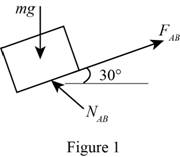
Concept explainers
A package is thrown down an incline at A with a velocity of 1 m/s. The package slides along the surface ABC to a conveyor belt that moves with a velocity of 2 m/s. Knowing that d = 6 m and μk = 0.2 between the package and all surfaces, determine (a) the speed of the package at C, (b) the distance the package will slide on the conveyor belt before it comes to rest relative to the belt.

(a)
Find the speed
Answer to Problem 13.12P
The speed
Explanation of Solution
Given information:
The velocity of conveyor
The coefficient of the static friction between package with surface
The distance between the point C to point B
The inclined angle of the member BA
The velocity at the point A
The distance between the point A to B (d) is
Assume the acceleration due to gravity (g) is
Calculation:
Calculate the weight of the conveyor (W) using the formula:
Substitute
Show the free body diagram of the package sliding from the corner A to B as in Figure (1).

Calculate the normal force at point AB
Substitute
Calculate the force at point AB
Substitute
Calculate the work done
Substitute
Show the free body diagram of the package sliding from corner B to C as in Figure (2).

Calculate the normal force at point BC
Substitute
Calculate the force at point BC
Substitute
Calculate the work done
Substitute
Assume the corner B has no energy.
Use work and energy principle which states that kinetic energy of the particle at a displaced point can be obtained by adding the initial kinetic energy and the work done on the particle during its displacement.
Find the speed
Substitute
Substitute
Therefore, the speed
(b)
Find the distance
Answer to Problem 13.12P
The distance
Explanation of Solution
Given information:
The velocity of conveyor
The coefficient of the static friction between package with surface
The distance between the point C to point B
The inclined angle of the member BA
The velocity at the point A
The distance between the point A to B (d) is
Assume the acceleration due to gravity (g) is
Calculation:
Calculate the force (F) using the formula:
Substitute
Calculate the work done
Here,
Substitute
Use work and energy principle which states that kinetic energy of the particle at a displaced point can be obtained by adding the initial kinetic energy and the work done on the particle during its displacement.
Find the distance
Substitute
Substitute
Therefore, the distance
Want to see more full solutions like this?
Chapter 13 Solutions
<LCPO> VECTOR MECH,STAT+DYNAMICS
- A 4 ft 300 Ib 1000 Ib.ft 350 Ib C 2 ft 3. 45° 250 Ib B. 3ft B 25ft 200 Ib 150 Ib Replace the force system acting on the frame shown in the figure by a resultant force (magnitude and direction), and specify where its line of action intersects member (AB), measured from point (A).arrow_forwardCan you research the standard percentage of Steam Quality in:(1.) Boiler - leaving boilerBoiler -> Out(2.) Condenser - coming in condenser In -> CondenserProvide reference Also define: steam quality, its purpose and importancearrow_forwardNumbers 1 and 2 and 5 are are optional problems. However, I only need the values (with units) of 3, 4 and 6. Thank you :)arrow_forward
- Three cables are pulling on a ring located at the origin, as shown in the diagram below. FA is 200 N in magnitude with a transverse angle of 30° and an azimuth angle of 140°. FB is 240 N in magnitude with coordinate direction angles α = 135° and β = 45°. Determine the magnitude and direction of FC so that the resultant of all 3 force vectors lies on the z-axis and has a magnitude of 300 N. Specify the direction of FC using its coordinate direction angles.arrow_forwardturbomachieneryarrow_forwardauto controlsarrow_forward
- auto controlsarrow_forward1 Pleasearrow_forwardA spring cylinder system measures the pressure. Determine which spring can measure pressure between 0-1 MPa with a large excursion. The plate has a diameter of 20 mm. Also determine the displacement of each 0.1 MPa step.Spring power F=c x fF=Springpower(N)c=Spring constant (N/mm)f=Suspension (mm) How do I come up with right answer?arrow_forward
 Elements Of ElectromagneticsMechanical EngineeringISBN:9780190698614Author:Sadiku, Matthew N. O.Publisher:Oxford University Press
Elements Of ElectromagneticsMechanical EngineeringISBN:9780190698614Author:Sadiku, Matthew N. O.Publisher:Oxford University Press Mechanics of Materials (10th Edition)Mechanical EngineeringISBN:9780134319650Author:Russell C. HibbelerPublisher:PEARSON
Mechanics of Materials (10th Edition)Mechanical EngineeringISBN:9780134319650Author:Russell C. HibbelerPublisher:PEARSON Thermodynamics: An Engineering ApproachMechanical EngineeringISBN:9781259822674Author:Yunus A. Cengel Dr., Michael A. BolesPublisher:McGraw-Hill Education
Thermodynamics: An Engineering ApproachMechanical EngineeringISBN:9781259822674Author:Yunus A. Cengel Dr., Michael A. BolesPublisher:McGraw-Hill Education Control Systems EngineeringMechanical EngineeringISBN:9781118170519Author:Norman S. NisePublisher:WILEY
Control Systems EngineeringMechanical EngineeringISBN:9781118170519Author:Norman S. NisePublisher:WILEY Mechanics of Materials (MindTap Course List)Mechanical EngineeringISBN:9781337093347Author:Barry J. Goodno, James M. GerePublisher:Cengage Learning
Mechanics of Materials (MindTap Course List)Mechanical EngineeringISBN:9781337093347Author:Barry J. Goodno, James M. GerePublisher:Cengage Learning Engineering Mechanics: StaticsMechanical EngineeringISBN:9781118807330Author:James L. Meriam, L. G. Kraige, J. N. BoltonPublisher:WILEY
Engineering Mechanics: StaticsMechanical EngineeringISBN:9781118807330Author:James L. Meriam, L. G. Kraige, J. N. BoltonPublisher:WILEY





